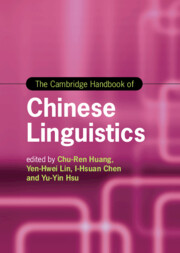Book contents
- The Cambridge Handbook of Chinese Linguistics
- Cambridge Handbooks In Language and Linguistics
- The Cambridge Handbook of Chinese Linguistics
- Copyright page
- Contents
- Figures
- Tables
- Contributors
- Acknowledgments
- Part One Writing System/Neuro-cognitive Processing of Chinese
- 1 Phonological Awareness, Orthography, and Learning to Read Chinese
- 2 Semantic Awareness in Reading Chinese
- Part Two Morpho-lexical Issues in Chinese
- Part Three Phonetic-phonological Issues in Chinese
- Part Four Syntax-semantics, Pragmatics, and Discourse Issues
- Index
- References
2 - Semantic Awareness in Reading Chinese
from Part One - Writing System/Neuro-cognitive Processing of Chinese
Published online by Cambridge University Press: 04 August 2022
- The Cambridge Handbook of Chinese Linguistics
- Cambridge Handbooks In Language and Linguistics
- The Cambridge Handbook of Chinese Linguistics
- Copyright page
- Contents
- Figures
- Tables
- Contributors
- Acknowledgments
- Part One Writing System/Neuro-cognitive Processing of Chinese
- 1 Phonological Awareness, Orthography, and Learning to Read Chinese
- 2 Semantic Awareness in Reading Chinese
- Part Two Morpho-lexical Issues in Chinese
- Part Three Phonetic-phonological Issues in Chinese
- Part Four Syntax-semantics, Pragmatics, and Discourse Issues
- Index
- References
Summary
The primary function of language is to convey what we mean for communication. Semantics, a subfield of linguistics, aims to understand how meanings are encoded and operate in different levels of linguistic forms (such as morphemes, words, phrases, sentences, and discourses). The cumulative evidence thus far has mainly been based on native speaker intuitions about the meanings of linguistic forms in language usage. With recent breakthroughs in neuroimaging techniques, neurolinguistic research has been used to test and evaluate theories put forth by theoretical linguistics by measuring the brain activity underlying language processes. This chapter reviews a series of neurolinguistics studies that took N400, an event–related potentials (ERPs) component to index the semantic processing, to investigate how the brain processes meaning conveyed by Chinese radicals, characters, classifiers, and the leading context of sentences. These findings make essential contributions to the growing understanding of when and how meanings are extracted, represented, and processed in the brain for language comprehension.
- Type
- Chapter
- Information
- The Cambridge Handbook of Chinese Linguistics , pp. 23 - 44Publisher: Cambridge University PressPrint publication year: 2022



